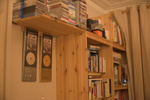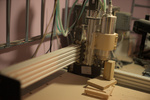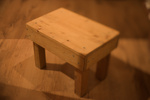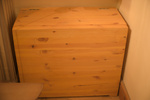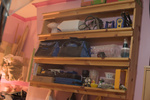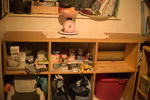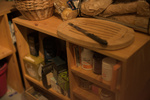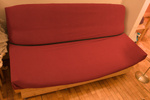I got busy; a pandemic happened and sort of hopefully tapered down to almost normal; in 2020 I began working remotely, and never went back to the office, meaning I have been staying at home and reading, writing, building and debugging code all day. During the long hours in lockdown I wasn’t too happy about doing more of the same after work -without the diversion of a different building, or room, or even desk-, so I became less active on the “coding for fun” front. I craved something different.
As a replacement activity I (re-)discovered woodworking.
I started with building a reasonably sized CNC machine in my spare room (yes, it’s backwards). First thing, I needed a workbench to place the machine on. For the machine I had in mind (about 80x70cm not counting cooling module and electronics), which called for a reasonably sized desk. To reduce waste, I converted the metal bunk sofa-bed of the spare room by replacing the mattress and mattress-holding frame with a 180x100cm pinewood tabletop reinforced with joists. This turned out perfect for the CNC machine and its accessories.
Once I had the CNC machine up and running - which took quite a while to design and put together - I was able to precisely cut 18mm thick redwood pine timber with relative ease, and started making small furniture and kitchen accessories with it. CNC allowed for freedom in shape design but was limited in cut size since the working area of that machine is about 50x50cm. This was not even close to large enough for my growing home improvement requirements.
Since expanding the CNC machine was not an option, I had to up my handiwork skills and my toolset. A few realisations, good and bad, shortly appeared:
- Moving around, cutting and putting back together large, therefore heavy, chunks of wood makes for good physical exercise, which was great during lockdown
- Sawing wood produces unexpected amounts of sawdust. Obviously, in hindsight, it shouldn’t have been so unexpected. I was kind of prepared for it since the CNC machine does it in first place and I had already built a basic extractor, but as soon as the scale of the project goes up, so does the volume of debris
- The process slows down asymptotically to a halt as the ratio between the size of the things being built and the size of the room they are been built in approaches one. This became even worse after I had to make the workshop also my working office for privacy reasons. I ended up having to build components in the workshop and assemble them at their final destination around the house, aircraft-pipeline style
- Need for tools whose usefulness and necessity were unimaginable arises. Luckily, those tools do exist and can be bought for a reasonable price. On the other hand, the extra room occupied by the new tools exacerbates the aforementioned dimensional problem
- As machining is removed from the equation, getting sub-millimeter precision requires an inordinate amount of skill and patience
Here’s a gallery of some of the stuff I’ve built along the years:
- Older handmade stuff
It all begun with hanging shelves within alcoves. I live in an old late-victorian house which is full of nook and crannies, which gave the opportunity to build some heavy-duty shelving with wall-bound support from two or three sides.
- CNC machined
The CNC machine opens up the option of building wacky shapes with curves and weird angles. I've stretched the capabilities of the machine with the revolving case in the picture below: it has a pentagonal plan and a curved outline, it's made of pine and bamboo, it has a bearing system for spinning, and it's held together by dry joints - with no need for glue of screws except to bind the spinning mechanism which is metal. It also maxes out the working area of the machine, which, at that point kind of hits an "evolutionary" dead end.
- Small and simple
Leftovers from other projects earn a new lease of life as simple utensils
- Stuff that can be called "furniture" if you squint enough
The CNC machine was too big for those, and since they were necessary for the house, it was either IKEA, or learning how to make boxy things by hand. I chose learning how to make boxy things "by hand" (I did use power tools such as a rail saw for long straight cuts, and a power drill.)
- The elephant in the room
This is by far the most complex thing I've built, and one of the largest. Took me several months from design to deployment and most of the work was carried out with hand tools. The seat and the back were built as separate components and assembled in place. It was hard work indeed, but it was extremely rewarding, and somehow exciting, to sit on it on the first time after deployment. Besides, the sofa has wheels, the seat dubs as a chest, and the back can be reclined to convert it into a larger bed.
I haven’t delved into details about my tool kit. Perhaps next time.


